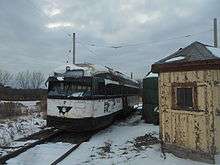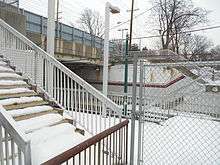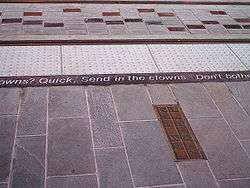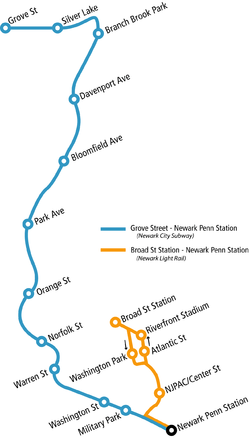Newark Light Rail
| Newark Light Rail | |||
|---|---|---|---|
 | |||
|
A Newark Light Rail car crosses Broad Street by Riverfront Stadium in Newark, pulling into the Newark Broad Street station. | |||
| Overview | |||
| Type | Light rail/Tram | ||
| System | New Jersey Transit | ||
| Locale | Essex County | ||
| Termini |
Newark Penn Station Grove Street (City Subway Line) Newark Broad St. (Broad Street Extension) | ||
| Stations |
5 (Broad Street Extension outbound) 4 (Broad Street Extension inbound) 11 (City Subway Line) | ||
| Services | 2 | ||
| Website | NJ Transit | ||
| Operation | |||
| Opened |
May 16, 1935 (City Subway)[1] 2006 (Broad Street Extension)[2] | ||
| Owner |
New Jersey Transit (within Newark) Norfolk Southern (in Belleville and Bloomfield) | ||
| Operator(s) | New Jersey Transit Bus Operations | ||
| Rolling stock | 20 Kinki Sharyo LRVs | ||
| Technical | |||
| Line length | 6.2 mi (10.0 km)[3] | ||
| Track gauge | 4 ft 8 1⁄2 in (1,435 mm) | ||
| Minimum radius | 33 ft (10.058 m)[4] | ||
| Electrification | 750 V (DC) overhead lines | ||
| |||
The Newark Light Rail (NLR) is a light rail system under New Jersey Transit Bus Operations serving Newark, New Jersey. The service consists of two segments, the original Newark City Subway (NCS), and the extension to Broad Street station.[5][6] The combined service was officially inaugurated on July 17, 2006.[2]
Newark City Subway

The Newark City Subway service is the longer and older of the two segments.[7] The line is a "subway-surface" light rail line which runs underground downtown and above-ground in outlying areas. Before becoming a part of the Newark Light Rail service, it was also known as the #7-City Subway line, an NJT Bus Operations route number that still applies internally (during system closures, buses would also bear the number "7 City Subway").
The segment is 5.3 mi (8.5 km) long and runs between Grove Street in Bloomfield and Newark Penn Station. Penn Station is a major transportation hub with connections to the PATH rapid transit system to Manhattan, multiple bus routes, and Amtrak.
History
The line opened in 1935 along the old Morris Canal right-of-way, from Broad Street (now known as Military Park) to Heller Parkway. Works Progress Administration artists decorated the underground stations with art-deco scenes from life on the defunct Morris Canal. The southernmost part, south of Warren Street, was capped with a new road, known as Raymond Boulevard. Only one grade crossing was present on the original subway; the line crosses Orange Street at grade so it can pass over the below-grade Delaware, Lackawanna and Western Railroad (now NJT Morristown Line) immediately to the north.
Operation of the complete subway to the planned terminal at Penn Station was delayed until the new Pennsylvania Railroad station above was completed in 1937. The terminal has five tracks, two incoming and three outgoing, connected by two loop tracks. This part of the subway included a grade-separated junction with a connection to the lower level of the Newark Public Service Terminal that was used for only a few months (June to September).
An extension to a wooden station at North 6th Street or Franklin Avenue was opened in 1940, located north of the present Branch Brook Park station. In 1953 the line was cut back about one block to accommodate construction of a turning loop, and a new station, still called Franklin Avenue, was opened adjacent to Anthony Street. The station was enlarged in 2002 and renamed Branch Brook Park.
The subway was operated by the Public Service Coordinated Transport as its No. 7 line. Other streetcar routes used parts of the subway, reaching street trackage at the locations shown below, ending as each route was closed and replaced by bus service:
- Public Service Terminal connection (and Cedar Street Subway), 1937 only: #13 Broad, #17 Paterson, #27 Mount Prospect, #43 Jersey City
- Warren Street ramp, 1935–1951: #21 Orange—West Orange via Market Street
- Central Avenue ramp, 1935–1947: #23 Central
- Orange Street crossing, 1935–1952: #21 Orange—West Orange via Orange Street
- Bloomfield Avenue ramp, 1935–1952: #29 Bloomfield
Until June 5, 1952, the Roseville Car House, on the south side of Main Street (on the No. 21 line) near the eastern city line of East Orange, was used for the No. 7 line. From that time until 2002, Newark Penn Station was used for storage and maintenance. A new shops and yard complex opened at the end of the extension to Grove Street.
Starting in January 1954, 30 PCC streetcars bought from Twin City Rapid Transit provided all service on the route. They were single-ended, requiring construction of a new turning loop at the Franklin Avenue terminal. The cars had been built 1946–1949 by the St. Louis Car Company and were sold by TCRT when that system went through a conversion to buses. Four cars were scrapped over the years, and two were sold to Shaker Heights Rapid Transit in 1978.
In 2001, new light rail cars built by Kinki Sharyo in Japan in 1999 replaced the PCCs. The last day of PCC service was August 24, 2001.[8]
New Jersey Transit took over operations in 1980.

Some of the PCCs are stored in the Newark City Subway shop. Eleven were sold in 2004 to the San Francisco Municipal Railway for use on its F Market heritage streetcar line.[9] One PCC, #15, was delivered to the Connecticut Trolley Museum in 2013 for restoration and display. One of the Shaker Heights cars has been restored by the Minnesota Transportation Museum, which operates it on a short stretch of track in western Minneapolis.
In 2005, eight PCCs were given to the City of Bayonne to be rehabilitated and operated along a proposed 2.5-mile (4 km) loop to serve the Peninsula at Bayonne Harbor, formerly Military Ocean Terminal at Bayonne (MOTBY). The proposed line would be connected to the 34th Street station of the Hudson-Bergen Light Rail.[10]
Broad Street Station was renamed Military Park Station on September 4, 2004, to avoid confusion with the terminal of the new route to Newark Broad Street Station.
Bloomfield extension

On June 22, 2002, the Newark City Subway was extended to the suburbs of Belleville and Bloomfield along what had been the former Erie Railroad Orange Branch, now under Norfolk Southern ownership. New stations were opened at Silver Lake and Grove Street, and the Heller Parkway and Franklin Avenue stations were combined into a new Branch Brook Park station. The loop at Franklin Avenue was removed, since the new vehicles are bidirectional, unlike the old PCCs—a new loop, however, is in place at the Grove Street facility. All the street crossings on the extension are at-grade.[11]
Shared-track operation
The original agreement gave sole operating privileges to Norfolk Southern between 11 pm and 5 am daily, but a new agreement allows passenger service to operate at all hours, with late-night service commencing on January 8, 2005. In exchange, Norfolk Southern can now operate during all off-peak hours, when passenger trains are infrequent.
Broad Street Extension

The Broad Street Extension is the second segment of the Newark Light Rail. It was planned as the first phase of the Newark-Elizabeth Rail Link. The line is one mile (1.6 km) long and connects Newark Penn Station to Broad Street Station. It branches off the older City Subway using the existing junction that had led to the Public Service terminal. A new tunnel leads from the junction to a portal about two blocks north. The remaining section runs above-ground. For a few blocks the two tracks run in different streets a block apart. One stop serves the New Jersey Performing Arts Center and another served the Bears and Eagles Riverfront Stadium. The extension opened on July 17, 2006.[2][12][13]
Construction began in 2002 with an estimated cost of $207.7 million, or about $40,000 per foot of track;[14] it was completed within budget.[15] Projections were for 4,000 average weekday boardings after one year, growing to about 7,000 in 2010. Actual weekday boardings in 2010 for both Newark Light Rail lines combined were reported at 9,000.[16]
The art work at the new stations has a common theme, "Riding with Sarah and Wayne." It is intended as a tribute to Newark's native daughter Sarah Vaughan and includes the lyrics to her signature song, "Send in the Clowns," and colored bricks representing the music notes.
Fares
The Newark Light Rail is equivalent to a one-zone bus ride, with the one-zone fare at $1.60 (as of October 1, 2015), and is valid for one hour on the entire system from the time the ticket is validated. A special $0.75 "Underground" fare is available for trips that use only the subway between Warren Street and Penn Station and not the surface portion. Through-ticketing is available for connecting bus routes. Monthly and weekly NJ Transit bus and rail passes valid for one or more local bus zones are accepted.
The Newark Light Rail, like most light rail systems in the United States, operates on a proof-of-payment system, in which riders must present their tickets upon request during random fare inspections. Passengers purchase tickets at ticket vending machines (TVMs). One-way and ten-trip tickets must be validated at automated validators located near the TVMs, which stamps the date and time on the ticket for 60 minutes of use. New Jersey Transit's fare inspectors perform random ticket inspections on vehicles and at stations. Fare evasions or passengers who fail to validate carry a fine of up to $100, and repeat offender are subject to criminal theft of service charges. On the PCC streetcars, cash fares (exact fare) were paid on board via farebox, except for a brief period starting in October 1999 prior to the introduction of LRVs, when proof-of-payment fare collection was instituted.
Stations
| Newark Light Rail | |||||||||||||||||||||||||||||||||||||||||||||||||||||||||||||||||||||||||||||||||||||||||||||||||||||||||||||||||||||||||||||||||||||||||||||||||||||||||||||||||||||||||||||||||||||||||||||||||||||||||||||||||
|---|---|---|---|---|---|---|---|---|---|---|---|---|---|---|---|---|---|---|---|---|---|---|---|---|---|---|---|---|---|---|---|---|---|---|---|---|---|---|---|---|---|---|---|---|---|---|---|---|---|---|---|---|---|---|---|---|---|---|---|---|---|---|---|---|---|---|---|---|---|---|---|---|---|---|---|---|---|---|---|---|---|---|---|---|---|---|---|---|---|---|---|---|---|---|---|---|---|---|---|---|---|---|---|---|---|---|---|---|---|---|---|---|---|---|---|---|---|---|---|---|---|---|---|---|---|---|---|---|---|---|---|---|---|---|---|---|---|---|---|---|---|---|---|---|---|---|---|---|---|---|---|---|---|---|---|---|---|---|---|---|---|---|---|---|---|---|---|---|---|---|---|---|---|---|---|---|---|---|---|---|---|---|---|---|---|---|---|---|---|---|---|---|---|---|---|---|---|---|---|---|---|---|---|---|---|---|---|---|---|
Legend | |||||||||||||||||||||||||||||||||||||||||||||||||||||||||||||||||||||||||||||||||||||||||||||||||||||||||||||||||||||||||||||||||||||||||||||||||||||||||||||||||||||||||||||||||||||||||||||||||||||||||||||||||
| |||||||||||||||||||||||||||||||||||||||||||||||||||||||||||||||||||||||||||||||||||||||||||||||||||||||||||||||||||||||||||||||||||||||||||||||||||||||||||||||||||||||||||||||||||||||||||||||||||||||||||||||||
Newark City Subway
| Station | Transfers | Notes |
|---|---|---|
| Newark Penn Station | NJ Transit buses: 1, 5, 11, 21, 25, 28, 29, 34, 40, 62, 67, 70, 71, 72, 73, 75, 76, 78, 79, 108, and 308, 319, 361, 375, 378 ONE Bus: 31, 44 NJ Transit rail: Northeast Corridor Line, North Jersey Coast Line, Raritan Valley Line Other: PATH trains to Jersey City, Hoboken, New York City, Amtrak to Philadelphia and points south, and New York Penn Station and points north, Greyhound, BoltBus |
|
| Military Park | NJ Transit buses: 13, 27, 39, 40, 41, 42, 43, 59, 62, 65/66, 67, 70, 72, 73, 76, 78 and 108 ONE Bus: 24, 44 |
formerly Broad Street; served the Newark Public Service Terminal |
| Washington Street | NJ Transit buses: 11, 28, 29, 70, 72, 76, and 78; ONE Bus: 44 (inbound only) | |
| Warren Street/NJIT | NJ Transit buses: 71, 73, and 79 | The station was renamed in 2011 to Warren Street/NJIT from Warren Street.[17] |
| Norfolk Street | NJ Transit buses: 99 ONE Bus: 24, 44 |
|
| Orange Street | NJ Transit buses: 71, 73, 75 | |
| Park Avenue | NJ Transit buses: 41 | |
| Bloomfield Avenue | NJ Transit buses: 11, 28, 29, 72 | |
| Davenport Avenue | none | |
| Heller Parkway | none | Closed June 21, 2002; Replaced by Branch Brook Park station. |
| Branch Brook Park | NJ Transit buses: 27, 74, 90, 92, 93 | |
| Franklin Avenue (formerly North 6th Street) |
none | Closed August 25, 2001; Replaced by Branch Brook Park station after the Bloomfield extension. |
| Silver Lake (Belleville) | NJ Transit buses: 27, 90 | |
| Grove Street (Bloomfield) | NJ Transit buses: 11, 28, 29, 72, 90 |
Broad Street Extension
| Station | Transfers | Notes |
|---|---|---|
| Newark Penn Station | NJ Transit buses: 1, 5, 11, 21, 25, 28, 29, 34, 40, 62, 67, 70, 71, 72, 73, 75, 76, 78, 79, 108, and 308, 319, 361, 375, 378 ONE Bus: 31, 44 NJ Transit rail: Northeast Corridor Line, North Jersey Coast Line, Raritan Valley Line Other: PATH trains to New York City, Amtrak to Philadelphia and points south, and New York City and points north. |
|
| NJPAC/Center Street | None | Line splits here. |
| Washington Park | NJ Transit buses: : 11, 13, 27, 28, 29, 39, 41, 42, 43, 59, 65, and 66 | Southbound Only |
| Atlantic Street | None | Northbound Only |
| Riverfront Stadium | NJ Transit buses: 11, 13, 27, 28, 29, 39, 43, 72, 76, 78 | Northbound Only |
| Newark Broad Street | NJ Transit buses: 11, 13, 27, 28, 29, 39, 41, 43, 72, 76, 78, and 108 NJ Transit rail: Gladstone Branch, Montclair-Boonton Line, Morristown Line |
On weekdays, service operates separately between the two sections. On weekends, service operates jointly.
Rolling stock
The Newark Light Rail system uses a new-model vehicle built by Kinki Sharyo of Japan. This vehicle, the same one used by the HBLR system, is a double-articulated vehicle with three sections. Each of the two end sections has an operator's cab at the far end, thus eliminating the need for the vehicle to turn itself around physically in order to reverse direction. Each end section also has seating for 16 passengers on an upper level, and seating for 13 passengers on the lower level, including one special fold-down seat next to an empty space that a passenger using a wheelchair may use. With these two sections, and a middle section that seats ten passengers (five on each side), the vehicle can comfortably accommodate 68 seated passengers and two wheelchairs. An additional 122 passengers could stand in the vehicle, if necessary. Vehicles can be coupled into two-unit sets. A contract to expand 10 of the 20 LRVs assigned to the Newark Light Rail system for the purpose of increasing passenger capacity was approved on July 9, 2014.[18]
The Seashore Trolley Museum in Kennebunkport, ME acquired PCC #5 in 2011.[19] The car represents the first piece of NJT rolling stock in the museum's collection. The car is currently undergoing restoration and rehabilitation work so that it may operate on the museum's 1 1/2 mile demonstration railway. Car #5 joins the museum's already-extensive collection of PCC cars from numerous cities, including Boston, Pittsburgh, Dallas, San Francisco, Philadelphia, Washington, D.C., and Kansas CIty.
Timeline
Historic dates
- December 22, 1910: The Public Service Corporation first announces plans to build the subway, initially including a line under Broad Street from Bridge Street to Clinton Avenue[20]
- May 16, 1935: The subway opens from Broad Street to Heller Parkway. The No. 21 line is routed onto the subway via the Warren Street Ramp and level junction at the Orange Street grade crossing. The No. 23 line is routed via the Norfolk Street Ramp. The No. 29 line starts using the Bloomfield Avenue Ramp.
- June 20, 1937: The extension to Newark Penn Station opens. This is the same day that the Hudson and Manhattan Railroad (present-day PATH) withdraws service from its Park Place terminal and first operates into its new alignment at Newark Penn Station. The No. 13, #27 and No. 43 lines are rerouted to Penn Station via the Cedar Street Subway; the No. 27 and No. 43 had used the lower level of the Newark Public Service Terminal.
- June 21, 1937: The No. 17 line is rerouted via the Cedar Street Subway.
- July 18, 1937: The No. 13 and No. 17 lines stop using the Cedar Street Subway.
- December 29, 1937: The No. 27 line stops using the Cedar Street Subway.
- May 1, 1938: The No. 43 line stops using the Cedar Street Subway, ending all service on that connection.
- November 22, 1940: The extension to North 6th Street (later Franklin Avenue) opens.
- December 14, 1947: The No. 23 line stops using the Norfolk Street Ramp.
- March 1, 1951: The No. 21 line stops using the Warren Street Ramp.
- March 29, 1952: The No. 21 line stops using the level junction at the Orange Street grade crossing.
- March 30, 1952: The No. 29 line stops using the Bloomfield Avenue ramps.
- January 8, 1954: The first PCC car uses the subway.
- October 1980: NJ Transit takes over operations.
- August 21, 1999: The subway is closed for two weeks for an overhaul.
- September 7, 1999: The subway reopens.
- August 24, 2001: The PCC cars are retired from service.[13]
- August 27, 2001: The new light rail vehicles begin operation.[21]
- June 21, 2002: Heller Parkway closes.[22]
- June 22, 2002: Silver Lake and Grove Street open.[22]
- September 4, 2004: Broad Street is renamed Military Park.[23]
- January 8, 2005: Additional late-night service is provided to Grove Street.[24]
- July 17, 2006: The Newark City Subway extension opens, with service between Newark Penn Station and Newark Broad Street. Service is rebranded as the Newark Light Rail.
Accidents
The Newark City Subway has had a few accidents over the years:
- September 22, 1981 – Nine passengers injured when an incoming trolley rammed into the rear of a stationary trolley at Newark Penn Station.[25]
- April 15, 2003 – A light rail vehicle was partially derailed at the grade crossing near Orange Street Station when a box truck rammed the vehicle from the side. The signal was in the light rail vehicle's favor.[26]
- August 23, 2008 – A dump truck making an illegal right turn crashed into a light rail vehicle at the Washington Park Station of the Broad Street segment causing it to partially derail. One passenger was injured.
- August 28, 2014 – A light rail vehicle crashed into a SUV between Atlantic Avenue and Broad Street. No passengers were injured.[27]
- April 6, 2016 – A light rail vehicle was hit by a car on South Franklin Avenue. No passengers were injured.[28]
In popular culture
- In November 2011 scenes for the movie The Dark Knight Rises were filmed at Military Park station.[29]
See also
- Hudson–Bergen Light Rail
- River Line
- Light rail in the United States
- List of tram and light rail transit systems
References
- ↑ Pirmann, David & Darlington, Peggy (2012). "world.nycsubway.org: Newark, New Jersey Light Rail/City Subway". nycsubway.org. David Pirmann.
- 1 2 3 "Newark light rail set to open july 17". NJ Transit. June 22, 2006. Retrieved 2013-08-07.
- ↑ "NJ Transit Facts At a Glance Fiscal Year 2014" (pdf). NJ Transit. March 2015. Retrieved 2015-04-02.
- ↑ On line pubs TRANSPORTATION RESEARCH BOARD EXECUTIVE COMMITTEE 1995]
- ↑ "Newark Light Rail" (PDF map). New Jersey Transit. August 2008. Retrieved 2015-09-06.
- ↑ "Newark Light Rail" (PDF map). New Jersey Transit. January 2014. Retrieved 2015-09-06.
- ↑ See Riley, John Harrington, "The Newark City Subway Lines," (1987). This scarce book, which covers the history of the subway lines and the predecessor horse and trolley lines, is occasionally available on Amazon.
- ↑ "Farewell to Newark PCCs" (October 2001). Tramways & Urban Transit, p. 386. Ian Allan Publishing.
- ↑ "Historic Streetcars in San Francisco". Market Street Railway. Retrieved 2013-04-01.
- ↑ Peninsula at Bayonne Harbor development plan, page 17, accessed July 25, 2006
- ↑ Staff. "Subway extension to open in summer, Newark officials hope that the $207.7 million downtown project will help spur a renaissance.", The Philadelphia Inquirer, February 13, 2006. Accessed July 18, 2011. "The last major expansion of the 4.3 mile subway in 2002 brought the service into the neighboring cities of Belleville and Bloomfield."
- ↑ "Capital Improvement Program - System Expansion Projects - Extension of the Newark Light Rail (NLR) to Newark Broad Street Station". NJ Transit. August 2006. Retrieved 2013-08-07.
- 1 2 Klufas, Michael (August 24, 2001). "NJ TRANSIT OFFICIALS, CUSTOMERS, TROLLEY ENTHUSIASTS SAY GOODBYE TO NEWARK CITY SUBWAY'S PCC CARS - New Light Rail Vehicles to Begin Service August 27". NJ Transit. Archived from the original on 2007-09-30. Retrieved 2015-09-06. Press Release 323.
- ↑ NJ TRANSIT Department of Capital Planning and Programs. "Extension of the Newark Light Rail (NLR) to Newark Broad Street Station". NJ Transit. Archived from the original on 2009-06-17. Retrieved 2015-09-06. Project 005.
- ↑ Stessel, Dan (July 17, 2006). "NEWARK LIGHT RAIL OPENS TO SUPPORT CITY'S ECONOMIC REVITALIZATION - Connects Newark's two train stations through business district". Archived from the original on 2007-09-27. Retrieved 2015-09-06. Press Release NJT-06-092, ID 2246.
- ↑ New Jersey Transit. Njtransit.com. Retrieved on 2014-06-23.
- ↑ Heyboer, Kelly (March 4, 2011). "Warren Street stop on Newark Subway line to get $40K makeover with help of NJIT student". The Star-Ledger. Retrieved March 5, 2011.
- ↑ Douglas John Bowen. "NJT OKs LRV add-ons - Railway Age". railwayage.com.
- ↑ Seashore Trolley Museum: Browse the Collection. Trolleymuseum.org. Retrieved on 2014-06-23.
- ↑ "Plan Newark Subway". New York Times. December 23, 1910.
- ↑ Klufas, Michael (August 27, 2001). ""NEW" NEWARK CITY SUBWAY DEBUTS - Smooth, Air-Conditioned Light Rail Vehicles Carry Customers in 21st Century Comfort". NJ Transit. Archived from the original on 2007-09-27. Retrieved 2015-09-06. Press Release 326.
- 1 2 "TWO NEW STATIONS TO OPEN ON THE NEWARK CITY SUBWAY - Expanded Service Begins/Weekend Service Resumes on June 22". NJ Transit. June 18, 2002. Archived from the original on 2007-09-30. Retrieved 2015-09-06. Press Release 510.
- ↑ "Customer Notice - Newark City Subway Broad Street Station Renamed Military Park Station". NJ Transit. Archived from the original on 2007-09-27. Retrieved 2015-09-06. Customer Notice 1227.
- ↑ "NEWARK CITY SUBWAY EXTENDS LATE NIGHT SERVICE, IMPROVES EFFICIENCY - Extra 2 hours of service to Grove Street begins January 8". NJ Transit. December 29, 2004. Archived from the original on 2006-11-13. Retrieved 2015-09-06. Press release NJT-04-084.
- ↑ "Subway Crash Hurts 9 at Terminal in Newark". The New York Times. September 22, 1981. Retrieved July 20, 2011.
- ↑ "Truck slams into Newark subway train". Star-Ledger. Newark. April 16, 2003.
- ↑ http://www.nj.com/essex/index.ssf/2014/08/service_delayed_after_nj_transit_light_rail_suv_crash_in_newark.html
- ↑ http://abc7ny.com/traffic/no-one-hurt-after-car-strikes-newark-light-rail/1278596/
- ↑ Mike Frassinelli (2013-02-10). "Holy subway, Batman! A hidden world of clean, on-time riding exists beneath Newark". The Star-Ledger. Retrieved 2013-05-17.
- Bibliography
- Edward Hamm, Jr., The Public Service Trolley Lines in New Jersey.
- DOT Docket FRA-2000-7335-7 and −8.
External links
| Wikimedia Commons has media related to Newark Light Rail. |
- NJ Transit – Light Rail Schedules
- Newark Light Rail & Proposals on Google Maps
- NYCSubway.org – Newark City Subway
- Abandoned Stations – Newark City Subway platforms

